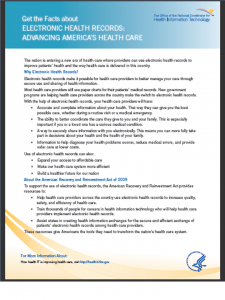CMS and ONC both Add to FAQs related to Health Information Exchange on 12/12/2010
Link to PDF of ONC’s 22 Regulations FAQs. Note FAQ #21 not yet posted.
The following FAQs were excerpted on 12/18/2010.
ONC Question [12-10-022-1]:
Does the certification criterion pertaining to electronic prescribing, which references certain content exchange standards (i.e., NCPDP SCRIPT 8.1 and NCPDP SCRIPT 10.6), require that a Complete EHR or EHR Module be capable of electronically exchanging information with only external recipients (i.e., recipients that are not part of that legal entity) according to the appropriate standard (and implementation specifications) or does it apply more broadly?
Answer:
For the certification criterion pertaining to electronic prescribing (45 CFR 170.304(b)), which references those two content exchange standards adopted at 45 CFR 170.205(b) and the vocabulary standard 170.207(d) (i.e., any source vocabulary that is included in RxNorm), a Complete EHR or EHR Module must be certified as being capable of electronically generating and transmitting prescriptions and prescription-related information to external recipients in accordance with the appropriate adopted standard(s) (and implementation specifications). These standards were adopted for the purpose of enabling a user of Certified EHR Technology to “exchange” electronically certain health information, as indicated in the first sentence of the regulatory section and the section title, and as alluded to in various other parts of the Standards and Certification Criteria Interim Final and Final Rules.
We intended the capability required by this certification criterion and the referenced standards and implementation specifications to apply to the electronic exchange of prescription information between different legal entities (e.g., from an eligible professional’s Certified EHR Technology to a pharmacy that is not part of the eligible professional’s legal entity), to complement how CMS has generally described “exchange” in the context of meaningful use as information “sent between different legal entities with distinct certified EHR technology or other system that can accept the information….” (75 FR 44361-62). In the Standards and Certification Criteria Interim Final Rule and in the Standards and Certification Criteria final rule, we discussed current Medicare Part D electronic prescribing regulatory requirements for using NCPDP SCRIPT 8.1, and the anticipated use of NCPDP SCRIPT 10.6. (75 FR 2031-32, 75 FR 44625-26). In both rules, we also had explained that the purpose of the adopted standards and certification criteria was not to specify how or when Certified EHR Technology must be used, but only what capabilities Certified EHR Technology must include. (75 FR 2022-23, 75 FR 44592-93). We sought to align the adopted standards, implementation specifications, and certification criteria with certain already established regulatory requirements to ensure that Certified EHR Technology would provide a base-level of capabilities to assist users in meeting those other regulatory requirements. (See, for example, 75 FR 44591, and 75 FR 44598.) Then, when discussing electronic prescribing, we referred to the adopted NCPDP SCRIPT standard as a standard required under the Medicare Part D e-prescribing regulations when “an entity sends prescriptions outside the entity (for example, from an HMO to a non-HMO pharmacy)….” (75 FR 2031-32, 75 FR 44592). Consequently, with respect to the capability a Complete EHR or EHR Module must demonstrate in order to be certified to the certification criterion adopted at 170.304(b), a Complete EHR or EHR Module must be capable of electronically transmitting prescriptions and prescription-related information to external recipients according to NCPDP SCRIPT 8.1 or 10.6 in addition to the adopted vocabulary standard for medications at 45 CFR 170.207(d).
This approach is consistent with a principle we established in the Standards and Certification Criteria Interim Final Rule where we sought to ensure that eligible health care providers seeking to meaningfully use Certified EHR Technology and engaging in electronic exchange would be able to do so in a manner that would be compliant with other applicable law. Thus, with respect to electronic prescribing, we adopted NCPDP SCRIPT 8.1 and 10.6 to ensure that when an eligible professional electronically transmits a prescription or prescription-related information for Medicare Part D covered drugs for Medicare Part D eligible individuals to, for example, a pharmacy that is not part of the legal entity of the eligible professional, the eligible professional would be able to do so using Certified EHR Technology and also comply with the Medicare Part D e-prescribing rules.
See CMS FAQ 10284 [ or immediately below] for information about how these transmissions should be counted.
CMS Question 10284 FAQ on EHR Incentive Program
For the meaningful use objective of “generate and transmit prescriptions electronically (eRx)” for the Medicare and Medicaid Electronic Health Record (EHR) Incentive Program, how should the numerator and denominator be calculated? Should electronic prescriptions fulfilled by an internal pharmacy be included in the numerator?
Published 12/17/2010 11:34 AM | Updated 12/17/2010 11:41 AM | Answer ID 10284
ANSWER
The denominator for this objective consists of the number of prescriptions written for drugs requiring a prescription in order to be dispensed, other than controlled substances, during the EHR reporting period. The numerator consists of the number of prescriptions in the denominator generated and transmitted electronically using certified EHR technology. In order to meet the measure of this objective, 40 percent of all permissible prescriptions written by the EP must be generated and transmitted electronically according to the applicable certification criteria and associated standards adopted for certified EHR technology as specified by the Office of the National Coordinator for Health IT (ONC).
ONC has released an FAQ stating that “with respect to the capability a Complete EHR or EHR Module must demonstrate in order to be certified to the certification criterion adopted at 170.304(b), a Complete EHR or EHR Module must be capable of electronically transmitting prescriptions to external recipients according to NCPDP SCRIPT 8.1 or 10.6 in addition to the adopted vocabulary standard for medications (45 CFR 170.207(d)).” Given such FAQ, prescriptions transmitted electronically within an organization (the same legal entity) would not need to use these NCPDP standards. However, an EP’s EHR must meet all applicable certification criteria and be certified as having the capability of meeting the external transmission requirements of §170.304(b). In addition, the EHR that is used to transmit prescriptions within the organization would need to be Certified EHR Technology.
The EP would include in the numerator and denominator both types of electronic transmissions (those within and outside the organization) for the measure of this objective. We further clarify that for purposes of counting prescriptions “generated and transmitted electronically,” we consider the generation and transmission of prescriptions to occur constructively if the prescriber and dispenser are the same person and/or are accessing the same record in an integrated EHR to creating an order in a system that is electronically transmitted to an internal pharmacy.
For more information about the Medicare and Medicaid EHR Incentive Program, please visit http://www.cms.gov/EHRIncentivePrograms.
ONC Question [12-10-023-1]:
Could an interface that transmits lab results in HL7 message format between a hospital laboratory system and a physician’s EHR (presuming that the transmissions were occurring between two different legal entities) satisfy the certification criteria related to the exchange of key clinical information in 45 CFR 170.304(i) and 45 CFR 170.306(f)? If not, please specify the required data types and exchange characteristics that must be part of the required clinical information exchange.
Answer:
As implied in the question, for certification a Complete EHR or an EHR Module must have the capability to electronically receive and display, and transmit certain key clinical information in accordance with one of two separate certification criteria (45 CFR 170.304(i) or 45 CFR 170.306(f)), depending on the setting for which the EHR technology is designed (ambulatory or inpatient, respectively). Generally speaking, these certification criteria require two types of information exchange capabilities – the capability to:
- Electronically receive and display a patient’s summary record, from other providers and organizations including, at a minimum, diagnostic tests results, problem list, medication list, and medication allergy list in accordance with the continuity of care document (CCD) standard (and the HITSP/C321 implementation specifications) or the continuity of care record (CCR) standard and that upon receipt of a patient summary record formatted according to the alternative standard, display it in human readable format.
- Electronically transmit a patient summary record to other providers and organizations including, at a minimum, diagnostic test results, problem list, medication list, and medication allergy list using the CCD standard (and the HITSP/C32 implementation specifications) or the CCR standard while also representing specific named data elements (problems, laboratory test results, and medications) according to adopted standards.
Note: The above uses language from 45 CFR 170.304(i). The certification criterion adopted at 45 CFR 170.306(f) also includes “procedures” as a required, standardized data element within these exchange capabilities.
Therefore, an interface that transmits lab results in HL7 message format between a hospital laboratory system and a physician’s EHR (where the transmission is occurring between two different legal entities) would not qualify as an exchange of key clinical information that complies with the requirements of either of these two certification criteria. The interface would not satisfy the required capabilities included within the adopted certification criteria, and more specifically, the ability to transmit a patient summary record in accordance with the CCD standard (and the HITSP/C32 implementation specifications) or the CCR standard.
1HITSP Summary Documents Using HL7 Continuity of Care Document (CCD)


